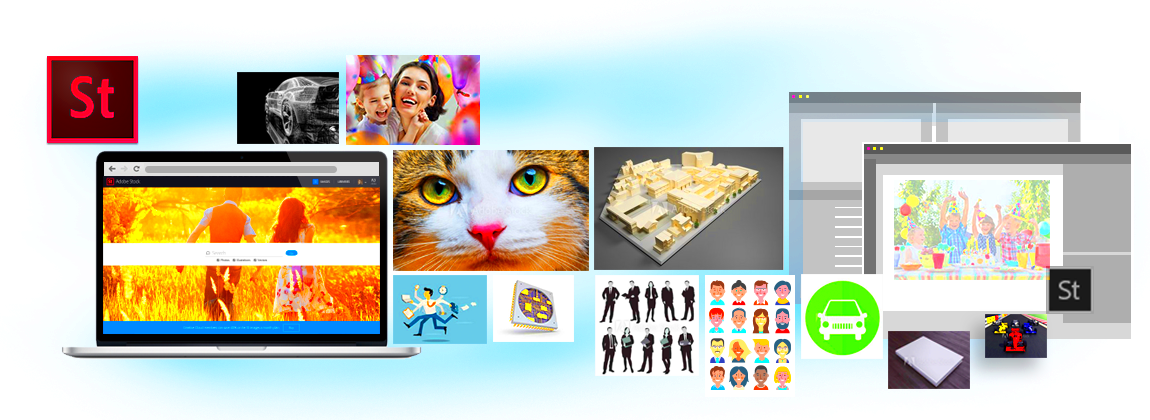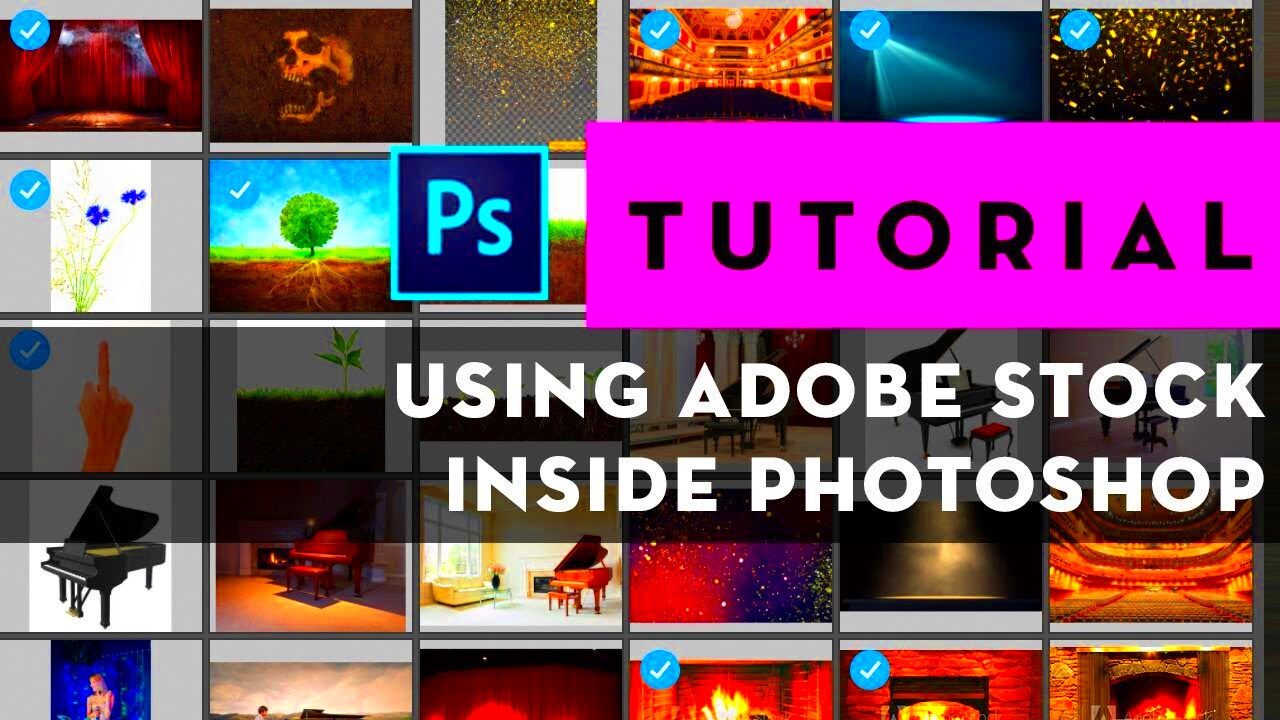Adobe Stock is a goldmine for designers and artists seamlessly integrated into Photoshop. Picture being able to tap into an extensive collection of top notch photos, artwork and footage while you’re busy with your creative endeavors. It’s akin to having a treasure trove of visual materials at your disposal. Whether you’re a seasoned pro or simply exploring your creative side
Adobe Stock can effortlessly bring your visions to fruition and streamline your workflow.
Getting Started with Adobe Stock

Starting your journey with
Adobe Stock is pretty easy, but being aware of some important steps can help things go more smoothly. Here’s a guide on how to get started:
- Sign Up for Adobe Stock: You need an Adobe account to use Adobe Stock. If you don’t have one, create an account at Adobe’s website. Once you’re signed in, you can access Adobe Stock through the Creative Cloud interface.
- Choose Your Plan: Adobe Stock offers various subscription plans, including monthly and annual options. Select a plan that suits your needs based on the volume of images you anticipate using.
- Install Adobe Creative Cloud: Ensure you have Adobe Creative Cloud installed on your computer. It’s the gateway to accessing Adobe Stock within Photoshop and other Adobe applications.
After finishing these steps you can seamlessly incorporate
Adobe Stock into your routine and begin discovering its extensive collection of assets.
Connecting Adobe Stock with Photoshop
Linking
Adobe Stock with Photoshop is a breeze. Check out this straightforward step by step guide to establish the connection.
- Open Photoshop: Launch Photoshop on your computer. Make sure you’re logged into the same Adobe account you used for Adobe Stock.
- Access Adobe Stock: In Photoshop, go to the “Libraries” panel. You’ll find this in the right-hand sidebar or by navigating to Window > Libraries.
- Browse Adobe Stock: Within the Libraries panel, click on the “Stock” tab. This will open Adobe Stock’s search interface. You can now browse, search, and preview images directly from within Photoshop.
- Log In to Your Adobe Account: If prompted, log in with your Adobe credentials to sync your Adobe Stock subscription with Photoshop.
Once you get connected you’ll discover how simple it is to bring in images and materials from
Adobe Stock to your Photoshop projects. This will make your creative process smoother and improve your overall efficiency.
Searching for Stock Images
Finding stock photos on Adobe Stock feels like going on a treasure hunt for visuals. With a wide range of choices at your disposal it's crucial to have a specific vision in mind. When I tried out Adobe Stock for the time I was impressed by the ease of use and effectiveness of the search feature. Here’s a straightforward guide to assist you in locating the image.
- Use Relevant Keywords: Start by entering specific keywords related to your project. For instance, if you need images of “sunset over mountains,” type in those exact words to narrow down your search results.
- Apply Filters: Adobe Stock offers various filters to refine your search. You can filter by image type (photo, illustration, video), color, orientation (landscape or portrait), and more. Applying these filters helps in finding the right match more quickly.
- Explore Collections: Sometimes, browsing through curated collections or popular categories can spark inspiration. Adobe Stock features curated collections that showcase trending or themed images.
- Check Similar Images: If you find an image close to what you need but not quite right, Adobe Stock often suggests similar images. This feature can help you find the perfect fit by exploring visually similar options.
With these suggestions, you'll efficiently discover top notch images that align with your creative requirements enhancing your design journey to be more seamless and enjoyable.
Previewing and Licensing Images
Exploring and obtaining images on Adobe Stock is the starting point for bringing your ideas to life. The procedure is crafted to be user friendly so you can easily evaluate and acquire the assets you need. Allow me to guide you through the process.
- Previewing Images: Once you’ve found an image you like, click on it to open the preview window. Here, you can see a larger view of the image and how it fits into your project. Adobe Stock also provides an option to add a watermark to the preview if you’re still deciding.
- Check Image Details: In the preview window, review the image details, including resolution, license type, and pricing. This information is crucial for ensuring the image meets your project’s needs.
- Select Licensing Option: Adobe Stock offers various licensing options, including standard and extended licenses. Choose the one that fits your usage requirements. For instance, if you plan to use the image for commercial purposes or in a product for resale, an extended license may be necessary.
- Purchase and Download: After selecting the appropriate license, proceed to purchase the image. Adobe Stock makes this easy with a secure checkout process. Once purchased, you can download the image in high resolution, ready for use in your project.
By following this procedure you can ensure that you have a clear view of the images you require while also ensuring they are properly licensed for your intended usage.
Downloading Images into Photoshop
Bringing in pictures to Photoshop from Adobe Stock is like adding the finishing touch to your creative masterpiece. The process is effortless and blends effortlessly into your routine. Here's a quick guide on how to make it happen:
- Open Photoshop: Make sure Photoshop is open and that you’re logged into the same Adobe account you used for purchasing the stock image.
- Access Adobe Stock Library: Go to the “Libraries” panel within Photoshop. Click on the “Stock” tab to view your Adobe Stock assets.
- Locate the Image: Find the image you purchased in the Adobe Stock library. You can search for it by name or browse through your recent downloads.
- Drag and Drop: Simply drag the image from the Libraries panel onto your Photoshop canvas. The image will appear in your project, ready for editing.
- Adjust and Edit: Once the image is in Photoshop, you can start adjusting and editing it to fit your design. Whether you need to crop, resize, or add filters, it’s all possible with Photoshop’s robust tools.
Bringing images into Photoshop is a breeze allowing you to concentrate on your artistic endeavors rather than getting bogged down by the nitty gritty aspects.
Managing Your Stock Images
Keeping your stock photos organized is like taking care of a tidy online archive. When I began using stock pictures I was initially daunted by the sheer number of files. But with some system in place it becomes second nature. Here are some tips to help you manage your stock photo library effectively.
- Create Folders: Organize your images into folders based on categories, projects, or themes. For example, you might have folders for “Marketing Materials,” “Social Media Posts,” or “Website Design.” This will help you find what you need quickly.
- Use Keywords: Tag your images with relevant keywords. Most image management systems, including Adobe Stock, allow you to add tags. This makes searching for specific images faster and more efficient.
- Regular Clean-Up: Periodically review your collection and remove any images you no longer need. This will help keep your library uncluttered and manageable.
- Sync with Creative Cloud: If you’re using Adobe Creative Cloud, sync your Adobe Stock library with it. This allows you to access your images across different Adobe applications seamlessly.
By following these steps handling your stock images will be a smooth process allowing you to concentrate more on your creative work instead of spending time searching for visuals.
Tips for Using Adobe Stock Efficiently
Making the most of Adobe Stock is similar to having a smoothly running engine at your disposal. Through my extensive use of Adobe Stock I’ve gathered some insights that have greatly improved my workflow. Here are a few suggestions I’ve found to be incredibly helpful:
- Leverage Collections: Create collections for different projects or clients. This way, you can easily access all related images without hunting through your entire library.
- Use the ‘Your Assets’ Feature: Adobe Stock allows you to save your favorite images to ‘Your Assets.’ This feature is perfect for quick access to images you frequently use or are considering for future projects.
- Download Watermarked Images: Before committing to a purchase, download watermarked versions of images. This lets you test how the image looks in your design without making an immediate investment.
- Utilize Advanced Search Options: Don’t just rely on basic searches. Use advanced search options to filter results by orientation, color, or even image style. This saves time and gets you closer to what you need.
- Stay Updated: Adobe Stock frequently updates its library with new images. Regularly check for new additions that might fit your needs, so you’re always up-to-date with fresh content.
By adopting these strategies you can maximize your experience with Adobe Stock leading to a more seamless and efficient creative workflow.
FAQ
What is Adobe Stock?
Adobe Stock is an offering that offers top notch stock images, artwork, clips and design templates. It smoothly works with Adobe Creative Cloud tools such as Photoshop, Illustrator and InDesign allowing users to effortlessly access and incorporate visual elements into their work.
How do I find the right image on Adobe Stock?
To find images for your project try searching with keywords that are relevant to your topic. You can use filters to refine your search results by image type, orientation, color and other criteria. If you need some creative ideas browsing through curated collections can also be beneficial.
Can I use Adobe Stock images for commercial projects?
Certainly, you can utilize Adobe Stock images for endeavors, as long as you choose the right license. Standard licenses are sufficient for most applications, but if you're planning on using the images on a larger scale or in high risk scenarios like merchandise or reselling products you might need to opt for an extended license.
How do I download images from Adobe Stock to Photoshop?
Once you buy an image you can find it in the Libraries panel of Photoshop. Just drag and drop the image from the Adobe Stock library onto your canvas. It will be all set for you to use and modify in your project.
Can I try images before purchasing?
Absolutely, Adobe Stock gives you the option to download previews of images with watermarks. This way, you can get a glimpse of how the image will look in your design before deciding to buy it.
Conclusion
In conclusion Adobe Stock is an excellent resource for individuals seeking to enrich their creative endeavors with top notch visuals and resources. Speaking from personal experience incorporating Adobe Stock into Photoshop has simplified my process and ignited a fresh wave of inspiration.By effectively organizing your stock photos conducting searches and taking advantage of the tools provided by Adobe Stock you can optimize your time and dedicate more attention to manifesting your artistic vision. Whether you're an experienced designer or a newcomer Adobe Stock can serve as a helpful ally on your creative path. Immerse yourself in it, explore its features and watch your imagination thrive!
 Starting your journey with Adobe Stock is pretty easy, but being aware of some important steps can help things go more smoothly. Here’s a guide on how to get started:
Starting your journey with Adobe Stock is pretty easy, but being aware of some important steps can help things go more smoothly. Here’s a guide on how to get started:
 admin
admin








